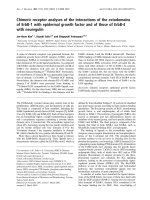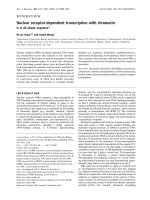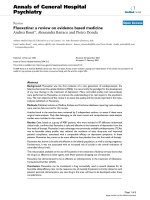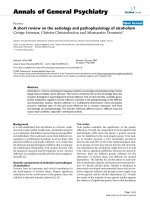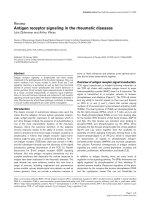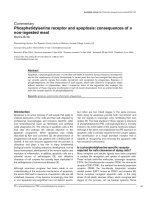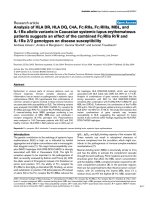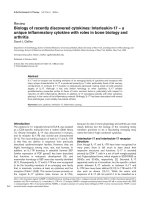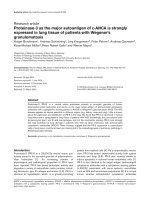Báo cáo y học: "Triggering receptor expressed on myeloid cells-1 expression on monocytes is associated with inflammation but not with infection in acute pancreatitis" pdf
Bạn đang xem bản rút gọn của tài liệu. Xem và tải ngay bản đầy đủ của tài liệu tại đây (769.92 KB, 8 trang )
Open Access
Available online />Page 1 of 8
(page number not for citation purposes)
Vol 13 No 3
Research
Triggering receptor expressed on myeloid cells-1 expression on
monocytes is associated with inflammation but not with infection
in acute pancreatitis
Eduardo Ferat-Osorio
1,2,3
*, Isabel Wong-Baeza
1,4
*, Noemí Esquivel-Callejas
1
, Silvia Figueroa-
Figueroa
5
, Andrés Duarte-Rojo
6
, Gilberto Guzmán-Valdivia-Gómez
7
, Heriberto Rodea-Rosas
5
,
Rubén Torres-González
8
, Patricio Sánchez-Fernández
2
, Lourdes Arriaga-Pizano
1
,
Constantino López-Macías
1
, Guillermo Robles-Díaz
9
and Armando Isibasi
1
1
Medical Research Unit on Immunochemistry, Specialties Hospital. National Medical Centre "Siglo XXI". Mexican Institute for Social Security (IMSS),
Mexico City, Mexico
2
Gastrointestinal Surgery Department, Specialties Hospital. National Medical Centre "Siglo XXI". Mexican Institute for Social Security (IMSS), Mexico
City, Mexico
3
PhD Program on Biomedical Sciences, Facultad de Medicina, Universidad Nacional Autónoma de México (UNAM), Mexico City, Mexico
4
Immunology Department, National School of Biological Sciences, National Polytechnic Institute, Mexico City, Mexico
5
General Surgery Department, General Hospital of Mexico, Mexico City, Mexico
6
Pancreatic Unit, National Institute of Medical Sciences and Nutrition "Salvador Zubirán", Mexico City, Mexico
7
General Surgery Department, Regional General Hospital "Carlos MacGregor Sánchez Navarro", IMSS, Mexico City, Mexico
8
Medical Unit of High Specialization (UMAE), "Dr. Victorio de la Fuente Narváez", IMSS, Mexico City, Mexico
9
Liver, Pancreas and Motility Laboratory (HIPAM), Experimental Medicine Department, Facultad de Medicina, Universidad Nacional Autónoma de
México, Mexico City, Mexico
* Contributed equally
Corresponding author: Armando Isibasi,
Received: 18 Mar 2009 Revisions requested: 15 Apr 2009 Revisions received: 5 May 2009 Accepted: 14 May 2009 Published: 14 May 2009
Critical Care 2009, 13:R69 (doi:10.1186/cc7876)
This article is online at: />© 2009 Ferat-Osorio et al.; licensee BioMed Central Ltd.
This is an open access article distributed under the terms of the Creative Commons Attribution License ( />),
which permits unrestricted use, distribution, and reproduction in any medium, provided the original work is properly cited.
Abstract
Introduction Acute pancreatitis (AP) is usually a mild and self-
limiting disease, but some patients develop a severe form that is
associated with high mortality. In AP, local inflammation is
followed first by the systemic inflammatory response syndrome
and then by the compensatory anti-inflammatory response
syndrome, which is defined by low human leukocyte antigen
(HLA)-DR expression on monocytes, increased concentration of
the anti-inflammatory cytokine IL-10, and decreased monocyte
function. Our aim was to measure the expression of triggering
receptor expressed on myeloid cells (TREM)-1 (a proposed
marker of infection or inflammation) and HLA-DR on monocytes,
and the serum concentrations of IL-6 (a proinflammatory
cytokine) and IL-10 in patients with AP to determine whether
these markers can identify patients at high risk of developing
severe AP or infection.
Methods Fifty healthy volunteers, 18 patients with mild AP, and
11 patients with severe AP were included in this study. Samples
were taken at admission and one and three days later. TREM-1
and HLA-DR expression was evaluated by flow cytometry, and
soluble TREM-1, IL-6 and IL-10 concentrations were measured
by ELISA.
Results TREM-1 expression was higher in patients with AP than
in healthy volunteers, but there was no difference between
patients with mild and severe AP. TREM-1 expression was not
associated with mortality or with the presence of infection.
Soluble TREM-1 concentration in serum was higher in non-
survivors than in survivors. HLA-DR expression was lower and
IL-6 concentration higher in patients with severe AP and in
infected patients.
AP: acute pancreatitis; APACHE: Acute Physiology and Chronic Health Evaluation; CARS: compensatory anti-inflammatory response syndrome;
ELISA: enzyme-linked immunosorbent assay; FITC: fluorescein isothiocyanate; HLA: human leukocyte antigen; IL: interleukin; MFI: mean fluorescence
intensity; PAMP: pathogen-associated molecular patterns; PE: phycoerythrin; SIRS: systemic inflammatory response syndrome; TNF: tumor necrosis
factor; TREM-1: triggering receptor expressed on myeloid cells-1.
Critical Care Vol 13 No 3 Ferat-Osorio et al.
Page 2 of 8
(page number not for citation purposes)
Conclusions Increased TREM-1 expression was associated
with the presence of inflammation but not infection in AP. In
patients with AP, low HLA-DR expression and high IL-6
concentration could predict severity and infection in samples
taken shortly after admission.
Introduction
Inflammation is essential for survival, but it can also be an
important cause of morbidity and mortality. One example of the
deleterious effects of inflammation is acute pancreatitis (AP).
Although AP is usually a mild and self-limiting disease, 20% to
31% of affected patients develop severe disease, and mortal-
ity rates can reach 25% in cases of infected pancreatic necro-
sis [1,2]. Intrapancreatic activation of digestive enzymes
causes local tissue damage and the release of proinflamma-
tory mediators by resident macrophages and acinar cells [3].
Proinflammatory cytokines are produced initially in the pan-
creas, and later in the liver, lungs, and spleen. The mechanism
causing this secondary cytokine production is unknown [4].
The systemic release of proinflammatory mediators in AP
causes a generalized inflammatory response in sites remote
from the initial injury site and gives rise to the systemic inflam-
matory response syndrome (SIRS) [5,6].
Patients who progress to severe AP have a high mortality rate
during their first week of evolution due to multiple organ failure.
Those who survive frequently develop extensive necrosis of
pancreatic and peripancreatic tissues [7], and 30% to 70% of
the latter become infected. In these infected patients, multiple
organ failure and death can ensue [8,9].
Infecting microorganisms contain pathogen-associated
molecular patterns (PAMPs) that are recognized by the innate
immune system and increase the production of adhesion mol-
ecules, proinflammatory cytokines, acute-phase proteins, nitric
oxide synthase, cyclooxygenase-2, and triggering receptors
expressed on myeloid cells-1 (TREM-1), among others [10].
TREM-1 is expressed on neutrophils and monocytes, and sig-
naling through TREM-1 induces the secretion of proinflamma-
tory cytokines and chemokines, and the expression of
costimulatory molecules [11]. This secondary inflammatory
response, or 'second-hit' response, can lead to tissue damage
and can orchestrate organ failure after the first week of AP
[12].
To restore homeostasis, the proinflammatory response is com-
pensated by anti-inflammatory mediators such as IL-10 and
soluble receptors that suppress the synthesis or the effects of
proinflammatory cytokines [13]. During SIRS, an anti-inflam-
matory response can develop, leading to what Bone [6]
defined as the compensatory anti-inflammatory response syn-
drome (CARS). SIRS is defined by clinical parameters [5],
while CARS is defined on molecular grounds by low levels of
major histocompatibility class II human leukocyte antigen
(HLA)-DR molecules on blood monocytes and by low produc-
tion of TNF-α when monocytes are challenged with PAMPs ex
vivo [14].
TREM-1 was initially proposed as an early marker of infection
because its expression is high in peritoneal neutrophils of sep-
tic shock patients [11]; a soluble form of TREM-1 is present in
high concentrations in bronchoalveolar lavage of patients with
pneumonia [15]; and soluble TREM-1 concentration is high in
the serum of septic patients [16]. However, other studies have
reported that TREM-1 expression increases in noninfectious
pathologies [17,18], and our previous results have shown that
the expression of this molecule increases after surgery, partic-
ularly in patients with preexisting SIRS, but without infection
[19]. In patients with AP, high levels of TREM-1 mRNA corre-
late with increased severity of the disease [20]. Cytokine anal-
ysis in patients with AP has attempted to establish markers of
severity (IL-6 or IL-8) or markers of progression (TNF-α or IL-
1β) [21,22].
The aim of our present study was to measure the levels of
TREM-1 and HLA-DR on monocytes, and the serum concen-
trations of IL-6 and IL-10 in patients with AP, and to determine
whether these markers can be used for early identification of
patients at high risk of developing severe AP or infection.
Materials and methods
Patients and controls
Twenty-nine patients from four hospitals (two general and two
referral hospitals) were included in this study, which was
approved on 13 September, 2006, by the Ethics and
Research Committee from each hospital and by the National
Committee for Scientific Research (No. 2006-785-080). The
patients or their legal representatives received detailed infor-
mation about this protocol, and, if they chose to participate,
signed an informed consent form.
All patients between 18 and 80 years with confirmed AP were
suitable to enter the study. AP diagnosis was based on the
presence of typical clinical symptoms and at least a threefold
increase in serum amylase or lipase concentration, and was
classified as mild or severe according to the Atlanta Criteria
[2,23]. Patients with more than 72 hours of evolution or
patients who had an exploratory laparotomy performed within
this time of evolution were not included. Other noninclusion
criteria were pregnancy; treatment with immune suppressors
or chemotherapy; HIV, hepatitis B virus or hepatitis C virus
infection; or the presence of neoplastic or autoimmune dis-
eases. A group of 50 healthy volunteers (blood bank donors)
was also included in this study for comparison purposes.
Available online />Page 3 of 8
(page number not for citation purposes)
Blood samples
In patients with AP, blood samples were drawn within 24
hours of admission (day 0), and one and three days later. One
sample was collected in an anticoagulant-free tube and
another in a lithium heparin-containing tube (4 ml each). In
healthy volunteers, the same samples were obtained on a sin-
gle occasion. Anticoagulant-free blood samples were centri-
fuged at 2500 rpm for 10 minutes, and the serum was
removed, and stored in aliquotes at -70°C until cytokine quan-
tification. The lithium heparin blood samples were processed
immediately for flow cytometry.
Antibodies
Fluorescein isothiocyanate (FITC)-labeled anti-CD14 mono-
clonal antibody and phycoerythrin (PE)-cyanine dye Cy5-
labeled anti-HLA-DR monoclonal antibody were purchased
from BD Biosciences Pharmingen (San Jose, CA, USA; clone
L243, mouse IgG2a, κ; and clone M5E2, mouse IgG
2a
, κ;
respectively). PE-labeled anti-TREM-1 monoclonal antibody
was obtained from R&D Systems (Minneapolis, MN, USA;
clone 193015, mouse IgG1). This combination of fluoro-
chromes allowed us to perform triple staining on each sample
to measure TREM-1 and HLA-DR expression on CD14
high
cells. In monocytes from healthy volunteers, 83.31% ±
11.27% of these cells expressed MHC-II, and the mean fluo-
rescence intensity (MFI) of TREM-1 was 343.5 ± 155. PE-
labeled mouse IgG1 and FITC-labeled mouse IgG2a were
used as isotype-matched controls.
Flow cytometry
In a polystyrene tube (BD Biosciences, San Jose, CA, USA),
50 μl of heparinized whole blood was mixed with 3 μl each of
anti-CD14, anti-HLA-DR, and anti-TREM-1 antibodies, or the
appropriate isotype controls, and incubated for 20 minutes at
4°C. Then, 250 μl of BD FACS lysing solution 1× (BD Bio-
sciences, San Jose, CA, USA) was added, the cells were incu-
bated for 10 minutes, and the stained cells were washed,
resuspended, and analyzed for three-color immunofluores-
cence by flow cytometry (FACS Aria, Becton Dickinson, Fran-
klin Lakes, NJ, USA). Cells with CD14
high
expression were
selected from a side scatter vs CD14/FITC dot plot. From this
gated region, cells expressing TREM-1/PE or HLA-DR/
PerCPCy5 were selected, using isotype controls as reference,
and MFI or percentage values of the selected cells were taken.
At least 5000 events in the CD14
high
region were analyzed.
Data analysis was performed using FACS Diva software ver-
sion 4.1 (Becton Dickinson, Franklin Lakes, NJ, USA).
Soluble TREM-1 and cytokine quantification
The concentration of soluble TREM-1 was measured in previ-
ously aliquoted serum samples using an ELISA kit (R&D Sys-
tems Minneapolis, MN, USA), according to the manufacturer's
protocol. The concentrations of IL-6 and IL-10 were measured
in previously aliquoted serum samples using ELISA kits (BD
Biosciences Pharmingen, San Jose, CA, USA), according to
the manufacturers' protocols.
Statistical analysis
Data are represented on box and whiskers graphs, which
depict median and 5% to 95% percentiles. Data were ana-
lyzed by Kruskal-Wallis test with Dunn's post hoc test using
GraphPad Prism version 5.0 (GraphPad Software, Inc., La
Jolla, CA, USA). Statistical significance was set at P < 0.05.
Results
Demographic data of patients and controls
Twenty-nine patients with AP were included in this study. Their
average age was 43 years (range, 17 to 79 years); 18 were
women and 11 were men. Twenty-two patients had AP of bil-
iary origin (75%), one patient had AP caused by alcohol con-
sumption (4%), one patient had AP caused by
hypertriglyceridemia (4%), and five patients had idiopathic AP
(17%). Eighteen patients had mild AP (62%), and 11 patients
had severe AP (38%). One patient with mild AP was dis-
charged from the hospital due to complete resolution of AP
before the third blood sample was taken.
Five patients with severe AP died; one patient developed res-
piratory insufficiency and died two days after admission to the
hospital; this patient died before the second blood sample had
been collected. The other four patients with severe AP that
died developed infections. One patient had pancreatic
abscess caused by Enterococcus faecalis (diagnosed on day
23, deceased on day 41). Another patient with AP from biliary
origin developed acute cholecystitis complicated with emphy-
sematous cholecystitis 2 days after the onset of AP, and dur-
ing the emergency laparotomy, purulent material was found in
abdominal cavity and pancreas inflammation was confirmed
(deceased on day 7). Two patients developed pneumonia; one
patient with Acinetobacter baumannii and Escherichia coli in
bronchoalveolar lavages (diagnosed on day 7, deceased on
day 20), and the other with clinical and radiological diagnosis
(diagnosed on day 4, deceased on day 5). A fifth patient with
severe AP developed urinary infection with Pseudomonas aer-
uginosa (diagnosed on day 18). So, one severe AP patient
developed infection during the period in which the blood sam-
ples were being collected (days 0 to 3), and four patients with
severe AP developed infection after this period.
Fifty healthy volunteers (blood bank donors) were also
included in this study; their average age was 34 years (range,
19 to 53 years); 11 were women and 39 were men.
TREM-1 expression is higher in patients with AP, but this
increase is not associated with mortality or with the
presence of infection
TREM-1 expression was significantly higher in all patients than
in healthy volunteers at each of the three times (Figure 1a).
However, the expression levels of TREM-1 did not differ
Critical Care Vol 13 No 3 Ferat-Osorio et al.
Page 4 of 8
(page number not for citation purposes)
between patients with mild and severe AP (Figure 1a),
between survivors and non-survivors (Figure 1b), or between
infected and non-infected patients (Figure 1c). Non-survivors
had higher soluble TREM-1 concentrations in serum than sur-
vivors on day 3 (Figure 1d). The concentrations of soluble
TREM-1 did not differ between patients with mild and severe
AP or between infected and non-infected patients with AP (not
shown).
HLA-DR expression is lower in patients with severe AP
and in infected patients
HLA-DR expression was lower in patients with severe AP than
in healthy volunteers at all times, and HLA-DR expression was
lower in patients with severe AP than in patients with mild AP
three days after admission (Figure 2a). The expression of HLA-
DR was lower in non-survivors than in healthy volunteers on
days 1 and 3 (Figure 2b). The expression of HLA-DR was also
significantly lower in infected patients three days after admis-
sion than in healthy volunteers (Figure 2c).
IL-6 and IL-10 concentrations were higher in patients
with severe AP and in infected patients
Serum IL-6 and IL-10 concentrations were significantly higher
in patients with AP at admission than in healthy volunteers
(Figures 3a and 4a). However, the cytokine concentrations
declined in patients with mild AP, but remained high in patients
with severe AP three days after admission (Figures 3a and 4a).
IL-6 concentration was higher in non-survivors than in healthy
volunteers three days after admission (Figure 3b), but no dif-
ference was observed in IL-10 concentrations at this point
(Figure 4b). Both cytokines were increased at admission in
uninfected patients but declined three days later (Figures 3c
and 4c). In contrast, in infected patients, IL-6 and IL-10 con-
Figure 1
TREM-1 expression was higher in patients with AP, but this increase was not associated with mortality, or with the presence of infectionTREM-1 expression was higher in patients with AP, but this increase was not associated with mortality, or with the presence of infection. (a) Trigger-
ing receptor expressed on myeloid cells-1 (TREM-1) expression was measured on blood monocytes from patients with mild acute pancreatitis (AP;
n = 18), patients with severe AP (n = 11), and healthy volunteers (n = 50). Samples were taken from patients on admission (day 0) and one and
three days later. One patient with mild AP was discharged from the hospital before the third blood sample was taken, and one patient with severe AP
died after the first blood sample was collected. (b) Patients with AP were grouped according to survival (24 of these patients survived and 5 died).
(c) Patients with AP were grouped according to the presence of infection (5 of the 29 patients developed infection). (d) Soluble TREM-1 expression
was measured in the serum of patients with AP, which were grouped according to survival. * P < 0.05, ** P < 0.01, *** P < 0.001; the signs over
each bar represent comparisons vs. healthy volunteers (H). MFI = mean fluorescence intensity.
Available online />Page 5 of 8
(page number not for citation purposes)
Figure 2
HLA-DR expression was lower in patients with severe AP and in infected patientsHLA-DR expression was lower in patients with severe AP and in
infected patients (a) Human leukocyte antigen (HLA)-DR expression
was measured on blood monocytes from patients with mild acute pan-
creatitis (AP; n = 18), patients with severe AP (n = 11), and healthy vol-
unteers (n = 50). Samples were taken from patients on admission (day
0) and one and three days later. One patient with mild AP was dis-
charged from the hospital before the third blood sample was taken, and
one patient with severe AP died after the first blood sample was col-
lected. (b) Patients with AP were grouped according to survival (24 of
these patients survived and 5 died). (c) Patients with AP were grouped
according to the presence of infection (five of the 29 patients devel-
oped infection). * P < 0.05, ** P < 0.01, *** P < 0.001; the signs over
each bar represent comparisons vs. healthy volunteers (H).
Figure 3
IL-6 concentration was higher in patients with severe AP and in infected patientsIL-6 concentration was higher in patients with severe AP and in
infected patients. IL-6 concentration was measured in serum from
patients with mild acute pancreatitis (AP; n = 18), patients with severe
AP (n = 11), and healthy volunteers (n = 36). Samples were taken from
patients on admission (day 0) and one and three days later. (a) Patients
with mild and severe AP, (a) survivors and non-survivors, and (c)
infected and non-infected patients are shown. * P < 0.05, ** P < 0.01,
*** P < 0.001; the signs over each bar represent comparisons vs.
healthy volunteers (H).
Critical Care Vol 13 No 3 Ferat-Osorio et al.
Page 6 of 8
(page number not for citation purposes)
centrations were higher than in healthy volunteers at admis-
sion and three days later (Figures 3c and 4c).
Discussion
One of the most serious complications of AP is the develop-
ment of infection. The aim of this study was to measure the lev-
els of TREM-1 and HLA-DR on monocytes and the serum
concentrations of IL-6 and IL-10 in patients with AP to deter-
mine whether these markers, alone or in combination, can be
used in the early identification of patients at high risk of devel-
oping severe AP or infection. Our results suggest that TREM-
1 expression increases in the presence of inflammation
because it was higher in all patients with AP, regardless of the
presence of infection. These results support our previous
study showing that TREM-1 expression increases after sur-
gery, particularly in patients with preexisting SIRS, but does
not correlate with the presence of infection [19]. TREM-1 may
be involved in the amplification of the inflammatory response in
AP, and its ligand could be an endogenous molecule released
during cellular damage associated with AP [24]. Wang and
colleagues found higher levels of TREM-1 mRNA in patients
with severe AP than in patients with mild AP and healthy vol-
unteers [20]. This seems in contrast to our results, but we
measured protein levels and not mRNA, and mRNA levels do
not necessarily correlate with protein levels.
TREM-1 can be shed from the surface of monocytes by matrix
metalloproteinases [25], and these enzymes are increased in
serum in animal models of severe AP [26,27] and in patients
with severe AP [28,29]. We found higher TREM-1 expression
on monocytes from patients with AP, compared with mono-
cytes from healthy volunteers, but the levels did not differ
between patients with mild and severe AP. Perhaps the metal-
loproteinases found in the serum of patients with severe AP
prevented a further increase on TREM-1 expression, but we
did not find differences in the concentrations of soluble TREM-
1 in serum between patients with mild and severe AP. How-
ever, we found that soluble TREM-1 concentration in serum
was higher in non-survivors than in survivors. This is in accord-
ance with the study by Yasuda and colleagues, who reported
that an increase in the serum concentration of soluble TREM-
1, in samples taken within the first 72 hours after the onset of
AP, correlated with Ranson score and Acute Physiology and
Chronic Health Evaluation (APACHE) II score, and that solu-
ble TREM-1 concentration was higher in patients with early
organ dysfunction [30], who have a higher risk of death.
Decreased levels of HLA-DR on blood monocytes and mono-
cyte hyporesponsiveness to PAMPs are suggested as possi-
ble causes of the increased predisposition to infection
observed in critically ill patients. Satoh and colleagues meas-
ured HLA-DR levels on blood monocytes at admission and 7
and 14 days after the onset of AP and found that a persistent
decrease in HLA-DR level was associated with the presence
of sepsis in later stages of the disease [31]. Mentula and col-
Figure 4
IL-10 concentration was higher in patients with severe AP and in infected patients.IL-10 concentration was higher in patients with severe AP and in
infected patients. IL-10 concentration was measured in serum from
patients with mild acute pancreatitis (AP; n = 18), patients with severe
AP (n = 11), and healthy volunteers (n = 19). Samples were taken from
patients on admission (day 0) and one and three days later. (a) Patients
with mild and severe AP, (b) survivors and non-survivors, and (c)
infected and non-infected patients are shown. * P < 0.05, ** P < 0.01,
*** P < 0.001; the signs over each bar represent comparisons vs.
healthy volunteers (H).
Available online />Page 7 of 8
(page number not for citation purposes)
leagues reported that patients with AP and secondary infec-
tions had lower HLA-DR levels on days 14 and 21 of evolution
than did healthy volunteers [32]. We measured HLA-DR
expression in patients with AP at earlier times and found lower
HLA-DR levels in patients with severe AP than in healthy vol-
unteers and patients with mild AP. We also found significantly
lower HLA-DR levels in infected patients three days after
admission. Our results suggest that the early measurement of
HLA-DR level might be useful for identifying patients with AP
who are likely to develop a severe form of the disease and who
are at high risk of infection.
Ho and colleagues found that HLA-DR expression on less than
52.3% of monocytes on the 10th day after admission corre-
lated with late mortality in patients with severe AP [33]. Our
results show that HLA-DR expression at early times does not
correlate with patient survival. Mentula and colleagues report
that low HLA-DR levels at admission correlate with the devel-
opment of organ dysfunction in patients with AP [34] but that
HLA-DR levels do not differ between survivors and nonsurvi-
vors [32]. Mentula and colleagues also report that organ fail-
ure in patients with severe AP could be predicted at admission
by a combination of high IL-6 and IL-10 concentrations [32]. In
this study, we found persistently high serum concentrations of
IL-6 and IL-10 in patients with severe AP and in patients who
developed infection, but not in patients with mild AP or unin-
fected patients.
Our results show that patients with severe AP had low HLA-
DR expression on monocytes and high serum IL-10 concentra-
tion since the beginning of their disease, which suggest that
they presented CARS and could have increased susceptibility
to infection. These also suggest that in severe AP, a disease
whose early state is a proinflammatory response, an anti-
inflammatory response (CARS) develops simultaneously and
probably increases the susceptibility to infection.
Conclusions
Membrane-bound TREM-1 is not useful for differentiating mild
and severe forms of AP, or for differentiating infected from
non-infected patients with AP, but an increase in TREM-1
expression is associated with the inflammatory process in
these patients. Non-survivors had higher soluble TREM-1 con-
centrations in serum than survivors. In patients with severe AP
and in those patients with AP who developed infection, we
observed low HLA-DR expression on monocytes and high
serum IL-6 concentrations in samples taken at admission and
one and three days later. We propose that this pattern could
be used to predict the development of severe AP and infec-
tion, although further studies are required to confirm this pre-
diction and to determine the appropriate cutoff values. The
measurement of HLA-DR expression by flow cytometry is sim-
ple and inexpensive, and could be implemented in clinical
practice.
Competing interests
The authors declare that they have no competing interests.
Authors' contributions
EFO, GRD, and AI conceived of the project. SFF, ADR,
GGVG, HRR, and PSF obtained blood samples from patients
and followed their clinical evolution. IWB, NEC, and LAP proc-
essed the samples. EFO, IWB, RTG, CLM, and AI analyzed
the results and wrote the paper.
Acknowledgements
This study was supported financially by Consejo Nacional de Ciencia y
Tecnología (CONACyT) (grant no. SALUD-2005-01-13942 to A. Isibasi
and SALUD-2004-01-132 to C. López-Macías). E. Ferat-Osorio and I.
Wong-Baeza received scholarships from CONACyT and I. Wong-Baeza
and N. Esquivel-Callejas from IMSS.
References
1. Mery CM, Rubio V, Duarte-Rojo A, Suazo-Barahona J, Pelaez-Luna
M, Milke P, Robles-Diaz G: Android fat distribution as predictor
of severity in acute pancreatitis. Pancreatology 2002,
2:543-549.
2. Swaroop VS, Chari ST, Clain JE: Severe acute pancreatitis.
JAMA 2004, 291:2865-2868.
3. Karne S, Gorelick FS: Etiopathogenesis of acute pancreatitis.
Surg Clin North Am 1999, 79:699-710.
4. Norman J: The role of cytokines in the pathogenesis of acute
pancreatitis. Am J Surg 1998, 175:76-83.
5. American College of Chest Physicians/Society of Critical Care
Medicine Consensus Conference: definitions for sepsis and
organ failure and guidelines for the use of innovative thera-
pies in sepsis. Crit Care Med 1992, 20:864-874.
6. Bone RC: Sir Isaac Newton, sepsis, SIRS, and CARS. Crit Care
Med 1996, 24:1125-1128.
7. Sakorafas GH, Tsiotos GG, Sarr MG: Extrapancreatic necrotiz-
ing pancreatitis with viable pancreas: a previously under-
appreciated entity. J Am Coll Surg 1999, 188:643-648.
8. Bhatia M, Brady M, Shokuhi S, Christmas S, Neoptolemos JP,
Slavin J: Inflammatory mediators in acute pancreatitis. J Pathol
2000, 190:117-125.
9. Isenmann R, Beger HG: Natural history of acute pancreatitis
and the role of infection. Baillieres Best Pract Res Clin Gastro-
enterol 1999, 13:291-301.
10. Ishii KJ, Koyama S, Nakagawa A, Coban C, Akira S: Host innate
immune receptors and beyond: making sense of microbial
infections. Cell Host Microbe 2008, 3:352-363.
11. Bouchon A, Facchetti F, Weigand MA, Colonna M: TREM-1
amplifies inflammation and is a crucial mediator of septic
shock. Nature 2001, 410:1103-1107.
12. Murphy TJ, Paterson HM, Kriynovich S, Zang Y, Kurt-Jones EA,
Mannick JA, Lederer JA: Linking the "two-hit" response follow-
ing injury to enhanced TLR4 reactivity.
J Leukoc Biol 2005,
77:16-23.
13. Karima R, Matsumoto S, Higashi H, Matsushima K: The molecular
pathogenesis of endotoxic shock and organ failure. Mol Med
Today 1999, 5:123-132.
14. Docke WD, Randow F, Syrbe U, Krausch D, Asadullah K, Reinke
P, Volk HD, Kox W: Monocyte deactivation in septic patients:
Key messages
• Increased TREM-1 expression on blood monocytes is
an indicator of inflammation but not of infection in
patients with AP.
• Low HLA-DR expression and high IL-6 concentration
could predict severity and infection in samples taken
shortly after admission.
Critical Care Vol 13 No 3 Ferat-Osorio et al.
Page 8 of 8
(page number not for citation purposes)
restoration by IFN-gamma treatment. Nat Med 1997,
3:678-681.
15. Gibot S, Cravoisy A, Levy B, Bene MC, Faure G, Bollaert PE: Sol-
uble triggering receptor expressed on myeloid cells and the
diagnosis of pneumonia. N Engl J Med 2004, 350:451-458.
16. Gibot S, Kolopp-Sarda MN, Bene MC, Cravoisy A, Levy B, Faure
GC, Bollaert PE: Plasma level of a triggering receptor
expressed on myeloid cells-1: its diagnostic accuracy in
patients with suspected sepsis. Ann Intern Med 2004,
141:9-15.
17. Adib-Conquy M, Monchi M, Goulenok C, Laurent I, Thuong M,
Cavaillon JM, Adrie C: Increased plasma levels of soluble trig-
gering receptor expressed on myeloid cells 1 and procalci-
tonin after cardiac surgery and cardiac arrest without infection.
Shock 2007, 28:406-410.
18. Radsak MP, Taube C, Haselmayer P, Tenzer S, Salih HR, Wie-
wrodt R, Buhl R, Schild H: Soluble triggering receptor
expressed on myeloid cells 1 is released in patients with sta-
ble chronic obstructive pulmonary disease. Clin Dev Immunol
2007, 2007:52040.
19. Ferat-Osorio E, Esqivel-Callejas N, Wong-Baeza I, Aduna-Vicente
R, Arriaga-Pizano L, Sánchez-Fernández P, Torres-Gonzáles R,
López-Macías C, Isibasi A: The increased expression of TREM-
1 on monocytes is associated with infectious and noninfec-
tious inflammatory processes. J Surg Res 2008, 150:110-117.
20. Wang DY, Qin RY, Liu ZR, Gupta MK, Chang Q: Expression of
TREM-1 mRNA in acute pancreatitis. World J Gastroenterol
2004, 10:2744-2746.
21. Bruno MJ: Current insights into the pathogenesis of acute and
chronic pancreatitis. Scand J Gastroenterol Suppl
2001:103-108.
22. Norman JG: New approaches to acute pancreatitis: role of
inflammatory mediators. Digestion 1999, 60(Suppl 1):57-60.
23. Bradley EL III: A clinically based classification system for acute
pancreatitis. Summary of the International Symposium on
Acute Pancreatitis, Atlanta, Ga, September 11 through 13,
1992. Arch Surg 1993, 128:586-590.
24. Wong-Baeza I, Gonzalez-Roldan N, Ferat-Osorio E, Esquivel-
Callejas N, duna-Vicente R, rriaga-Pizano L, studillo-de l V, Villasis-
Keever MA, Torres-Gonzalez R, Estrada-Garcia I, Lopez-Macias C,
Isibasi A: Triggering receptor expressed on myeloid cells
(TREM-1) is regulated post-transcriptionally and its ligand is
present in the sera of some septic patients.
Clin Exp Immunol
2006, 145:448-455.
25. Gomez-Pina V, Soares-Schanoski A, Rodriguez-Rojas A, Del
Fresno C, Garcia F, Vallejo-Cremades MT, Fernandez-Ruiz I, Arnal-
ich F, Fuentes-Prior P, Lopez-Collazo E: Metalloproteinases shed
TREM-1 ectodomain from lipopolysaccharide-stimulated
human monocytes. J Immunol 2007, 179:4065-4073.
26. Keck T, Jargon D, Klunsch A, Thomusch O, Richter S, Friebe V,
Adam U, Hopt UT: MMP-9 in serum correlates with the devel-
opment of pulmonary complications in experimental acute
pancreatitis. Pancreatology 2006, 6:316-322.
27. Muhs BE, Patel S, Yee H, Marcus S, Shamamian P: Inhibition of
matrix metalloproteinases reduces local and distant organ
injury following experimental acute pancreatitis. J Surg Res
2003, 109:110-117.
28. Chen P, Yuan Y, Wang S, Zhan L, Xu J: Serum matrix metallo-
proteinase 9 as a marker for the assessment of severe acute
pancreatitis. Tohoku J Exp Med 2006, 208:261-266.
29. Nakae H, Endo S, Inoue Y, Fujino Y, Wakabayashi G, Inada K, Sato
S: Matrix metalloproteinase-1 and cytokines in patients with
acute pancreatitis. Pancreas 2003, 26:134-138.
30. Yasuda T, Takeyama Y, Ueda T, Shinzeki M, Sawa H, Takahiro N,
Kamei K, Ku Y, Kuroda Y, Ohyanagi H: Increased levels of solu-
ble triggering receptor expressed on myeloid cells-1 in
patients with acute pancreatitis. Crit Care Med 2008,
36:2048-2053.
31. Satoh A, Miura T, Satoh K, Masamune A, Yamagiwa T, Sakai Y,
Shibuya K, Takeda K, Kaku M, Shimosegawa T: Human leukocyte
antigen-DR expression on peripheral monocytes as a predic-
tive marker of sepsis during acute pancreatitis. Pancreas
2002, 25:245-250.
32. Mentula P, Kylanpaa ML, Kemppainen E, Jansson SE, Sarna S,
Puolakkainen P, Haapiainen R, Repo H: Plasma anti-inflamma-
tory cytokines and monocyte human leucocyte antigen-DR
expression in patients with acute pancreatitis. Scand J Gastro-
enterol 2004, 39:178-187.
33. Ho YP, Sheen IS, Chiu CT, Wu CS, Lin CY: A strong association
between down-regulation of HLA-DR expression and the late
mortality in patients with severe acute pancreatitis. Am J Gas-
troenterol 2006, 101:1117-1124.
34. Mentula P, Kylanpaa-Back ML, Kemppainen E, Takala A, Jansson
SE, Kautiainen H, Puolakkainen P, Haapiainen R, Repo H:
Decreased HLA (human leucocyte antigen)-DR expression on
peripheral blood monocytes predicts the development of
organ failure in patients with acute pancreatitis. Clin Sci
(Lond) 2003, 105:409-417.
